
3troubleshootingjunos
.pdf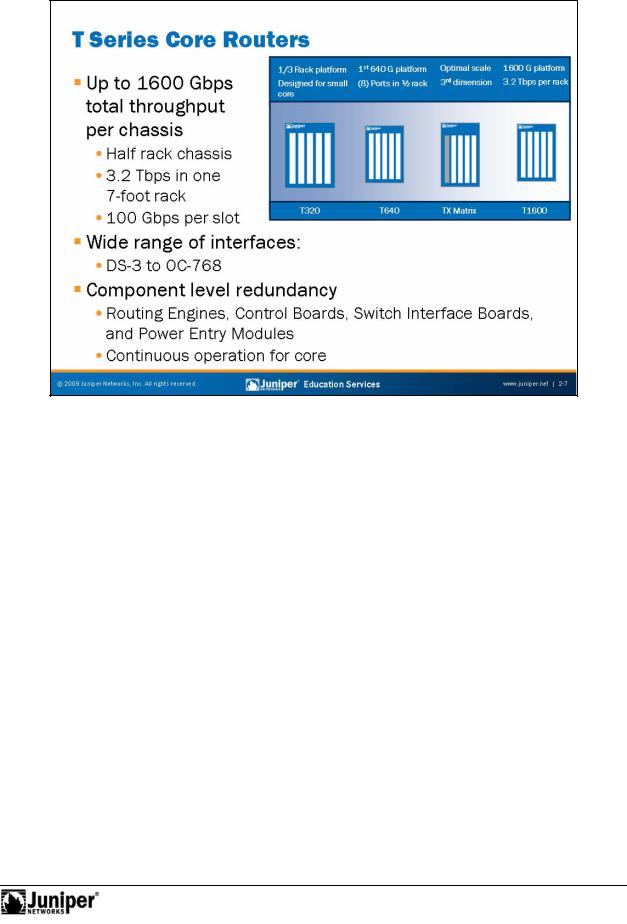
Not
Troubleshooting JUNOS Platforms
Total ChassisReproductionThrough ut
Juniper Networks T S ri s routers range from the T320, designed for a small network core, to the T1600, capable of offering 3.2 Tbps. The T1600 is a multichassis-capable core router that you can upgrade in-service from existing T640 routers. The scale and density of the T1600 allows service providers to increase capacity without adding
forequipment to the network, saving valuable floor space, rack space, and power consumption.
Range of Interfaces
T Series routers provide edge interfaces as well as the core functions required for consolidated point of presence (POP) solutions. All T Series routers, from the T320 to the T1600 and TX Matrix, support a wide range of interfaces, ranging from DS-3 to OC-768, including Asynchronous Transfer Mode (ATM), SONET, Ethernet, and both fixed and tunable dense wavelength-division multiplexing (DWDM) interfaces.
Components Level Redundancy
No single point of failure exists in the entire product line of T Series routers—including Routing Engines (REs), Control Boards (CBs), Switch Interface Boards (SIBs), and Power Entry Modules (PEMs). The redundancy in these components provides high availability and continuous operation in core routing, where loss of a single routing node can remove service for a wide geographical area.
Overview of JUNOS Platforms • Chapter 2–7
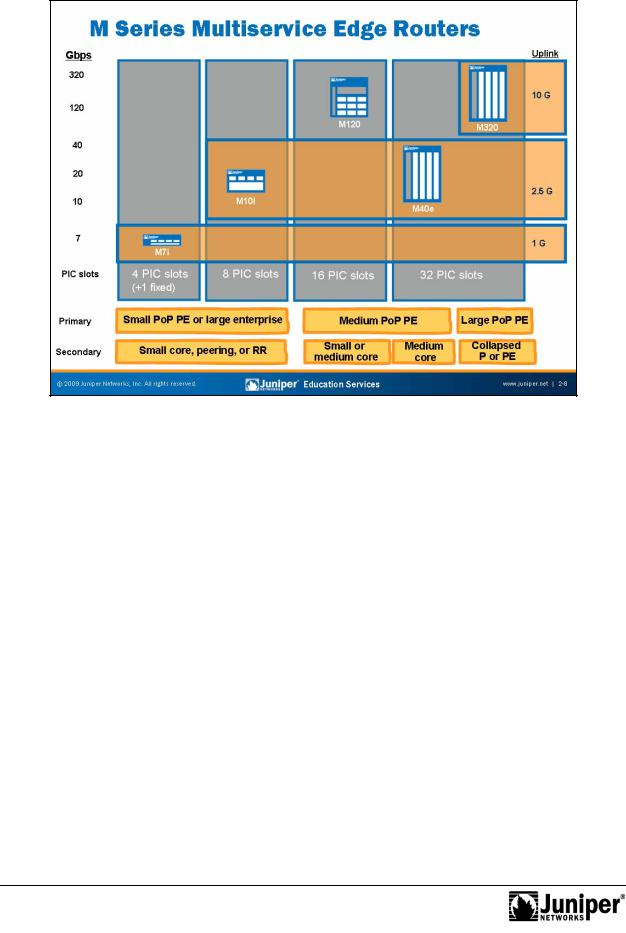
Troubleshooting JUNOS Platforms
The M Series portfolio rang s from 7 Gbps platforms to 320 Gbps platforms. You can deploy M Series rout rs in various roles within your network. The M Series portfolio uniquely combines IP/MPLS capabilities with service richness, stability, reliability, and
forsecu ity. The M Se ies routers allow service providers to consolidate multiple networks on a single IP/MPLS infrastructure. You can deploy the M Series platforms as a multise vice edge outer, a small or a medium core router, a route reflector, or a
M Series MultisReproductionrvice Edge Routers
pee ing device. It can also be deployed in multicast, mobile, or data center applicati ns. The M10i and higher-end M Series routers offer RE and Control Board redundancy.
Not
Chapter 2–8 • Overview of JUNOS Platforms
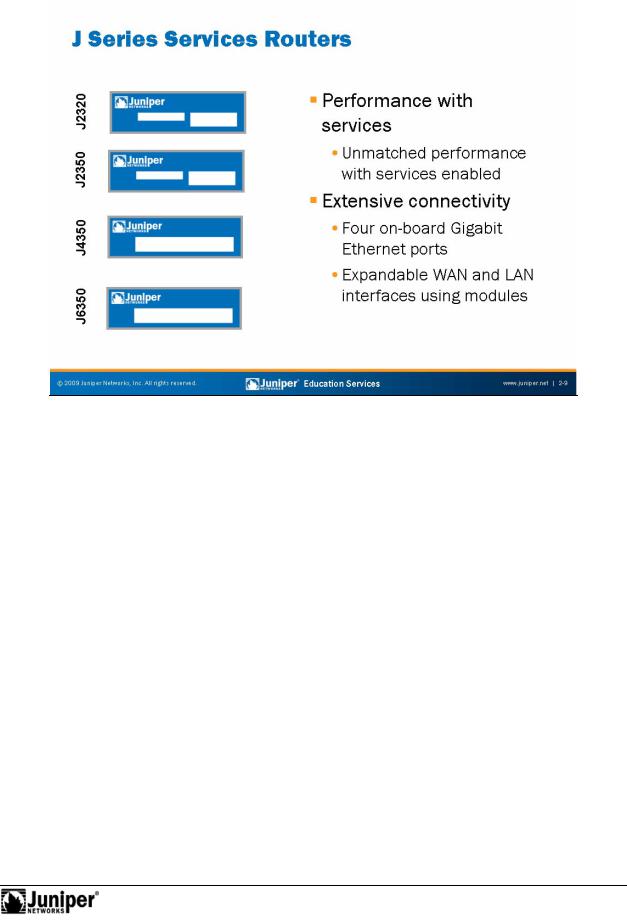
Troubleshooting JUNOS Platforms
|
|
Reproduction |
|
|
|
|
|
||
|
|
J Series P rformance and Services |
||
|
|
J Series rout rs maintain rformance even when you enable advanced services such |
||
|
|
as Network Addr ss Translation (NAT), access control lists, and stateful firewalls. |
||
|
|
Modular JUNOS Software provides key routing and security features such as stateful |
||
|
for |
|||
|
|
fi ewalls, IPsec, MPLS, and IPv6, defending against infrastructure attacks and fully |
||
|
|
p otecting the processing resources. |
||
|
|
J Se ies Extensive Connectivity |
||
|
|
J Series routers provide a large selection of connectivity options including T1 and E1, |
||
Not |
Serial, Fast Ethernet, Gigabit Ethernet, DS3, E3, ISDN, ADSL2+, and G.SHDSL. The |
|||
product options include hardware encryption acceleration, power supplies, DRAM, compact flash, and feature licenses. All J2320, J2350, J4350, and J6350 routers ship with four fixed 10/100/1000 Ethernet ports. You can add more modular LAN and WAN interfaces.
Overview of JUNOS Platforms • Chapter 2–9
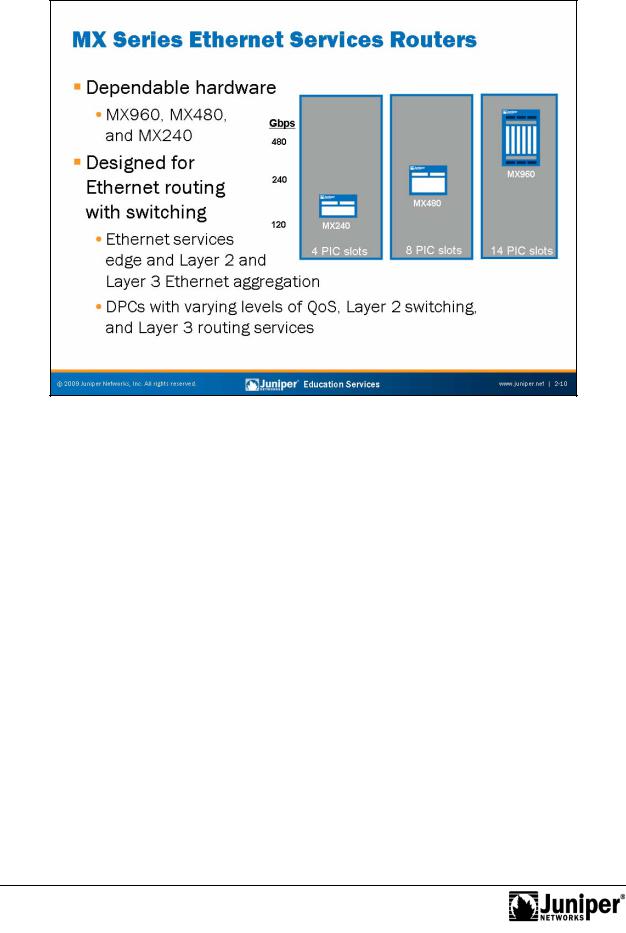
Troubleshooting JUNOS Platforms
MX Series Ethern t S rvic s Routers Hardware
|
MX Series routers (MX960, MX480, and MX240) provide Ethernet switching |
|
capabilities without sacrificing the carrier-class routing features customers expect |
|
from Juniper Networks. MX Series routers surpass the requirements of carrier-grade |
|
Ethe net switches as defined by the Metr Ethernet Forum, leveraging the MPLS |
|
capabilities that have made Juniper Networks routers the platforms of choice for |
|
service p ovide s seeking maximum performance, availability, and service agility. By |
|
extending the caReproductionier-class routing functionality of JUNOS Software to include LAN |
|
switching functionality to facilitate migration and growth, Juniper Networks brings its |
|
traditi nal advantages to Ethernet aggregation. These advantages include |
|
high-perf rmance routing capabilities such as nonstop routing (NSR), MPLS, fast |
|
reroute, and unified in-service software upgrade. |
for |
|
Not |
Ethernet Routing with Switching Design |
|
|
Running the same version of JUNOS Software shared by all Juniper Networks core and edge platforms, MX Series routers not only separate control and forwarding functions, but the Ethernet switching separates Layer 2 and Layer 3 forwarding with the intelligence to bridge when possible and route when needed. The platforms support Dense Port Concentrator (DPC) interface cards, offering enhanced queuing capabilities, QoS, L2 switching, and L3 routing services.
Chapter 2–10 • Overview of JUNOS Platforms
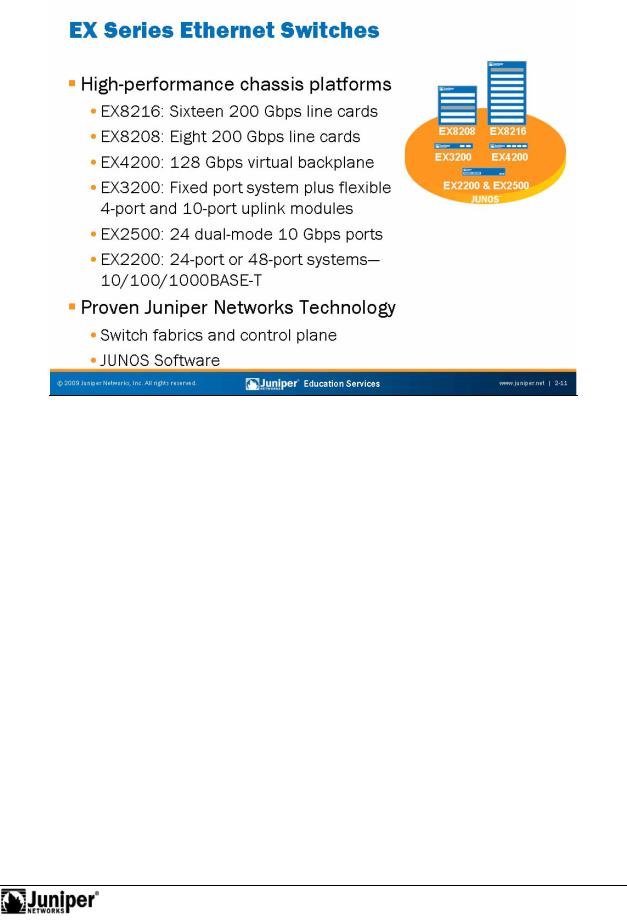
Troubleshooting JUNOS Platforms
|
|
Reproduction |
|
|
||
|
|
|
||||
|
|
EX Series Eth rn |
t Switches |
|||
|
|
The EX Seri |
s Eth rn |
t Switches offer flexible, powerful, and modular platforms that |
||
|
|
deliver the |
rformanc , scalability, and high availability required for today’s |
|||
|
|
high-density data center, campus aggregation, and core switching environments. The |
||||
|
for |
|
|
|
|
|
|
|
platfo ms range from the EX2200 to the EX8216 systems, which could include fixed |
||||
|
|
po ts and modular line cards of up to 10 Gbps. |
||||
|
|
P ven JUNOS Software Technology |
||||
|
|
The EX8200 line Switch Routing Engines (SREs) process all Layer 2 and Layer 3 |
||||
Not |
protocols and manage individual chassis components, while the switch fabric module |
|||||
provides the central crossbar matrix through which all data traffic passes. The SRE and switch fabric modules work together to fulfill all RE and switch fabric functions.
The EX Series Ethernet switches run the same JUNOS Software that Juniper Networks routers run. By utilizing a common operating system, Juniper Networks delivers a consistent implementation and operation of control plane features across all products. To maintain that consistency, JUNOS Software adheres to a highly disciplined development process that uses a single source code, follows a single quarterly release train, and employs a highly available modular architecture that prevents isolated failures from bringing an entire system down.
Overview of JUNOS Platforms • Chapter 2–11
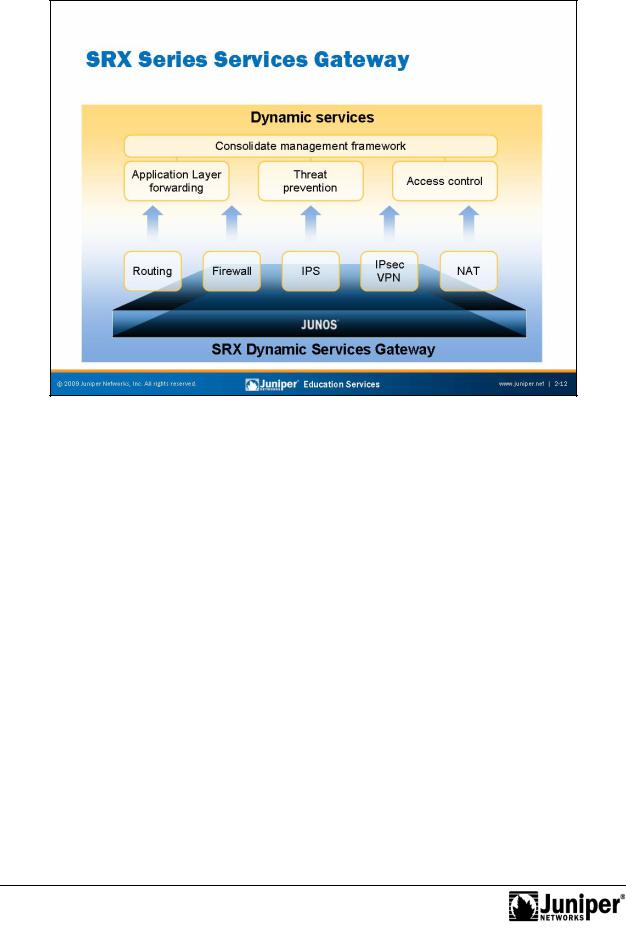
Troubleshooting JUNOS Platforms
Not
forprocessing scalability,Reproductioninput-output scalability, and services integration, the SRX Se ies devices meet the network and security requirements of data center
SRX Series Servic s Gat way
Juniper Networks SRX S ri s S |
rvic s Gateways are the next-generation solution for |
securing the ever incr asing |
twork infrastructure and application requirements for |
both enterprise and service providers. Designed from the ground up to provide flexible |
|
consolidation, managed services deployments, and aggregation of security solutions. Running JUNOS Software, which incorporates the Juniper Networks routing heritage and service provider reliability, the SRX Series also offers the high feature and service integrati n necessary to secure modern network infrastructure and applications.
Chapter 2–12 • Overview of JUNOS Platforms
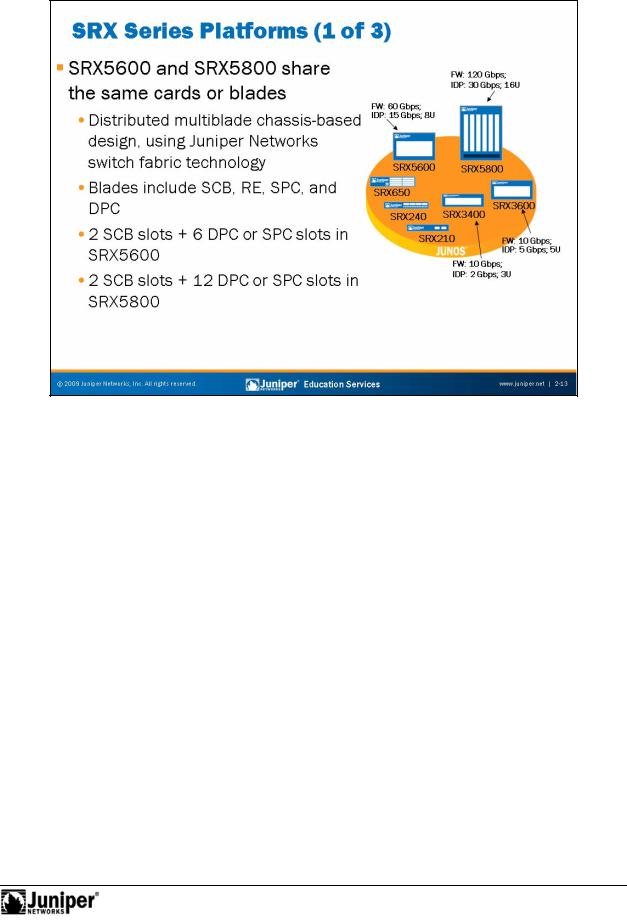
Not
Troubleshooting JUNOS Platforms
SRX5600Reproductionand SRX5800
SRX5600 and SRX5800 are next-generation services gateways based new architecture that provid s unprecedented scalability and service integration. The devices are ideally suited for large enterprise and service provider networks. Based on
forthe Dynamic Services Architecture, the SRX5600 uses the same services processing ca ds (SPCs) and input/output cards (IOCs) as the SRX5800. The SRX5800 can suppo t a more than 120 Gbps firewall and 30 Gbps IDP traffic. The SRX5600 can supp t up to a 60 Gbps firewall and 15 Gbps IDP traffic.
Overview of JUNOS Platforms • Chapter 2–13
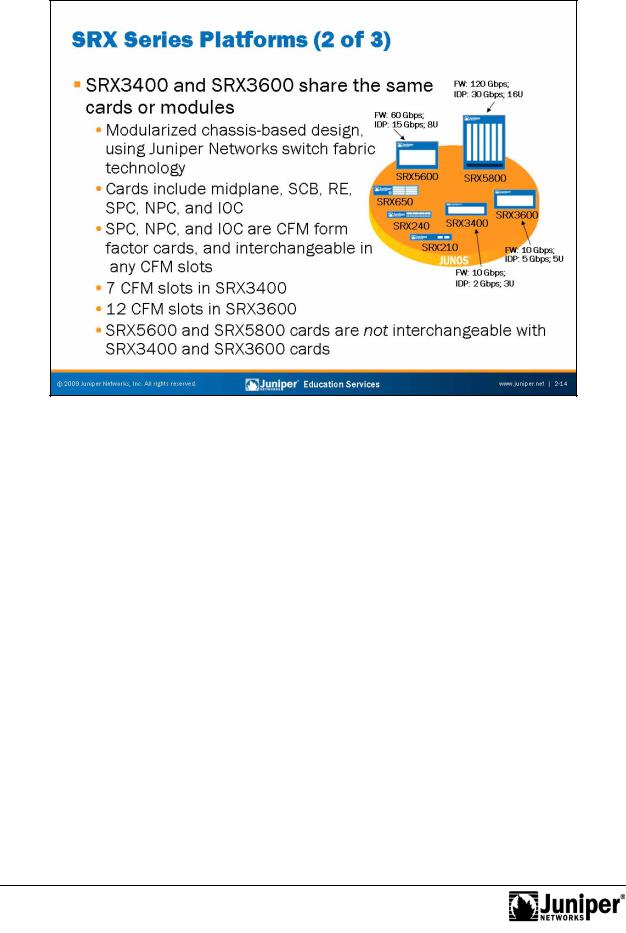
Troubleshooting JUNOS Platforms
Not
The SRX3400 and SRX3600 off r native support for firewalls, VPNs, switching, carrier-class Ethern routing, and IDP. Each device is flexible and scalable, with multiple, interchangeable physical interface cards and security cards, including the
formidplane, E, SPCs, network processing cards (NPC), Switch Control Board (SCB), IOC, Common Fo m-Factor Modules (CFMs), and DPCs. The SRX3600 can support an
SRX3400 andReproductionSRX3600 Cards and Modules
app oximately 10 Gbps firewall and 5 Gbps IDP traffic. The SRX3400 can support a 10 Gbps fi ewall and 2 Gbps IDP traffic. SRX3000 cards and SRX5000 cards are not interchangeable.
Chapter 2–14 • Overview of JUNOS Platforms
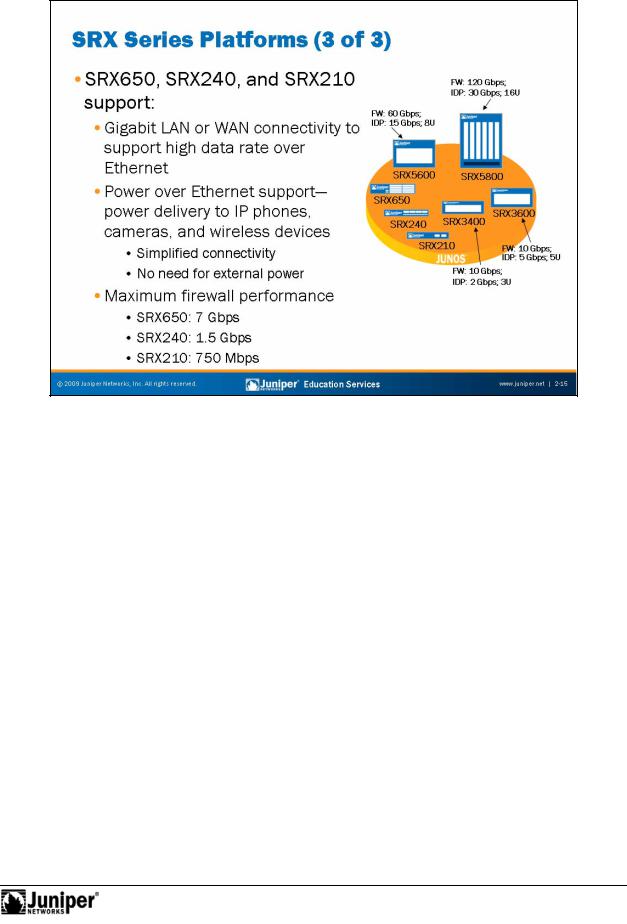
Not
Troubleshooting JUNOS Platforms
SRX650,ReproductionSRX240, and SRX210
The SRX650, SRX240, and SRX210 provid full firewall and Unified Threat Managem nt (UTM), ncompassing antivirus, IDP, Web filtering, and antispam to secure branch offices with a wide range of interfaces for WAN connectivity.
forThe S X210 Power over Ethernet (PoE) feature simplifies IP phone, camera, and wi eless support by delivering power to those devices without any need for external p wer.
The maximum firewall performance for the SRX650 is 7 Gbps, while it is 1.5 Gbps for the SRX240, and 750 Mbps for the SRX210.
Overview of JUNOS Platforms • Chapter 2–15
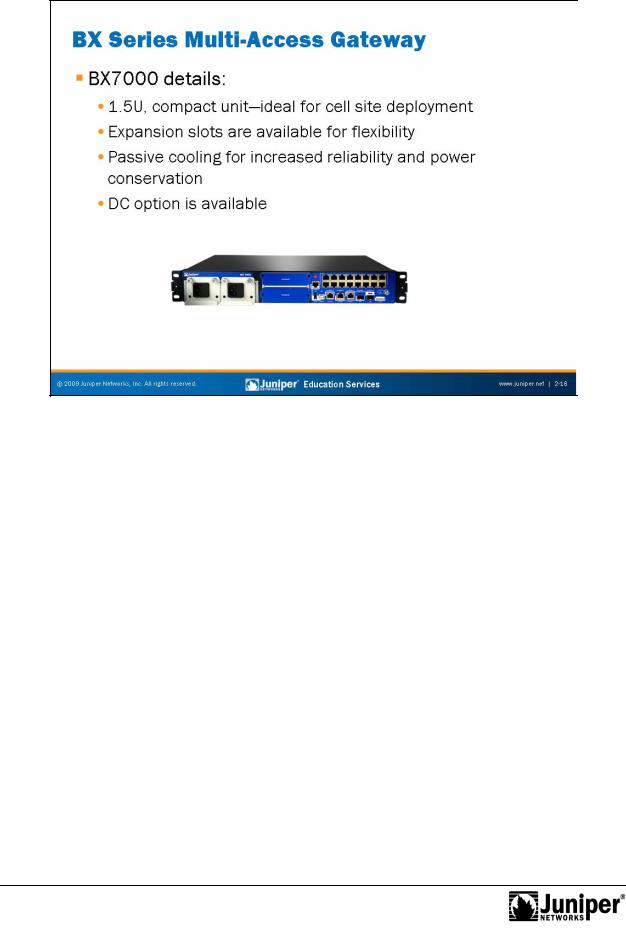
Troubleshooting JUNOS Platforms
Not
Reproduction |
|
|
|
|
|||
BX Series Multi-Acc |
ss Gat way |
||
The BX7000 Multi-Acc |
ss Gat way ffectively addresses the backhaul evolution |
||
challenge for mobile op |
rators with the most operationally efficient approach. The |
||
BX7000 is a compact platform that enables ease of its deployment in a cell site forcabinet with limited rack space. Additionally, it is available in an environmentally
ha dened m factor for deployment scenarios where cabinets could have additional exposu e to natu al elements.
Chapter 2–16 • Overview of JUNOS Platforms
